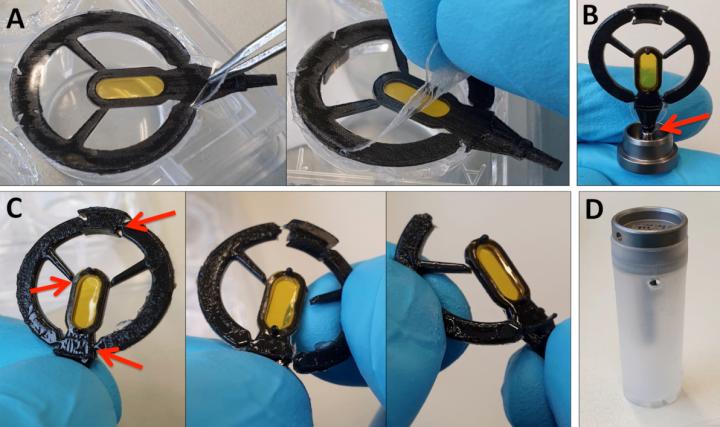Easier handling and less risk for fragile crystals

Credit: HZB
Proteins are huge molecules that often have complex three-dimensional structure and morphology that can include side chains, folds, and twists. This three-dimensional shape is often the determining factor of their function in organisms. It is therefore important to understand the structure of proteins both for fundamental research in biology and for the development of new drugs. To accomplish this, proteins are first precipitated from solution as tiny crystals, then analysed using facilities such as the MX beamlines at BESSY II in order to generate a computer image of the macromolecular structure from the data.
Up to now, protein crystals have first been grown and then transferred onto a sample holder for structural analysis. However, this transfer entailed a risk of destroying the often extremely fragile crystals.
This risk is no longer necessary thanks to the new sample holder developed by Dr. Manfred Weiss and Dr. Christian Feiler from the MX team together with Dr. Dirk Wallacher from the BESSY II sample environment group. Instead, the protein solution is applied directly onto the sample holder and crystallised in place, eliminating the need to transfer the delicate protein crystals to a different sample holder for analysis. “The new sample holder saves work steps and reduces the risk of damaging the sensitive protein crystals”, explains Feiler. “We have a short video clip that shows step-by-step how these sample holders facilitate protein crystallography – you have to see this!” exclaims Weiss, head of the MX-Beamline.
In practice, a large number of samples are always measured at once, so 24 sample holders are grouped together onto one sample plate. The new sample holder is patented in Germany and registered for an international patent. Jena Bioscience has acquired a licence and is already marketing the new development worldwide.
###
Media Contact
Antonia Roetger
[email protected]
Original Source
https:/
Related Journal Article
http://dx.




